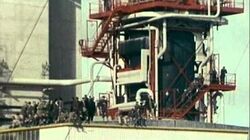
Windscale Britains Biggest Nuclear Disaster (Nothing compared to Fukushima).
Windscale - Britain's Biggest Nuclear Disaster (Nothing compared to Fukushima on the INES Scale).
Overview[]
Royal ordinance Factory Sellafield (ROF Sellafield) was constructed on the Sellafield industrial site in 1942. Near by ROF Drigg which produced the explosive TNT (AKA- trinitrotoluene, or more specifically 2,4,6-trinitrotoluene, a chemical compound with the formula C6H2(NO2)3CH3). Thad been constructed in 1940, 7 km to the south-east and adjacent to the village of Drigg.
Windscale facility on the north-west coast of England in Cumberland (now Sellafield, Cumbria). Sellafield is a nuclear reprocessing site, close to the village of Seascale on the coast of the Irish Sea in Cumbria, England. It is a short way south of and major employer of the town of Whitehaven.
The gas fueled Fellside Power Station was built when the nuclear development began to supply power to them.
The atomic incidents[]
The 1957 accident[]
The major event evolved a reactor fire and the released of radioactive particles Windscale, Britain's first nuclear reactor. It happened in the same year as the Soviet Kyshtym (Urals Mountains) disaster.
Scientists had been warning about the dangers of an accident for some time, especially those at the Nuclear Research Laboratory in Harwell. Unfortunately Whidscale continued to to go hell for leather and negate common seance issues in order to make more weapons grade plutonium. The accident was ultimately due to the lack of knowledge engineers and physicists had at that time about the behaviour of graphite irradiated at relatively low temperatures.
Since the start-up of the reactor 'piles', they had observed a spontaneous and sometimes dangerous release of energy, and used the 'annealing' of graphite moderator rods to prevent any dangerous rises in temperature. These procedures were effective but still poorly understood. A technically too rapid release of energy triggered off a dreaded fire that ripped through the radioactive materials in the core of Windscale. It was caused by the incorrect annealing of graphite moderator in the air-cooled reactor that caused the graphite and the metallic uranium fuel rods to over heat and to catch fire, releasing some radioactive pile material as dust into the environment. As a result masses of fission products were released into the atmosphere resulted in radioactive contamination that spread across northern Europe, with fallout being detected in Ireland, Belgium, Germany and Norway.
When it was discovered that radioactivity, and specially Iodine-131, had been released into the atmosphere and was settling on the round in Cumberland and Dumfries-shire, steps were taken to prohibit milk consumption in a 200 square miles area around Windscale.
The British government also feared an angry USA would demand an end to the UK's own or a joint Anglo-American H-bomb in favor of a safer all American job. A few years later the UK did explode its own H-bomb.
It was a Level 5 INES Scale event, but it relay should be put at level 6! Those who preach Windscale Denialism say it was only a level 3 or 4 event!
The alleged 5 Sellafield accidents of 1955 to 1979[]
They are allegedly 5 still partly covered-up Level 4 INES Scale events involving coolant and steam leeks.
Other lesser atomic issues[]
The THORPE Plant has had a Level 3 INES Scale event in 2005 and the Calder Hall power station also had a Level 1 INES Scale event in the 1960s.
Also see[]
- Atomic accidents and disasters
- Leningrad Nuclear Power Plant accidents
- Corporate malfeasance at the Peach Bottom Nuclear Generating Station
- UK OTL atomic reactors in 1962
Links[]
- https://en.wikipedia.org/wiki/International_Nuclear_Event_Scale
- https://www.iaea.org/Publications/Factsheets/English/ines.pdf
- http://www.damninteresting.com/the-windscale-disaster/
- http://www.radioactivity.eu.com/en/site/pages/Windscale_Accident.htm
- http://iopscience.iop.org/0952-4746/27/3/E02/pdf/jrp7_3_e02.pdf
- https://en.wikipedia.org/wiki/Windscale_fire
- http://news.bbc.co.uk/1/hi/7030281.stm
- http://www.lakestay.co.uk/1957.htm
- http://www.todayifoundout.com/index.php/2013/12/windscale-nuclear-disaster/
- http://www.telegraph.co.uk/news/science/science-news/3309842/Windscale-fire-We-were-too-busy-to-panic.html
- http://www.laradioactivite.com/en/site/pages/Windscale_Accident.htm
- http://www.takepart.com/photos/11-worst-nuclear-accidents/windscale-pile-great-britain-ines-level-5-1957
- http://www.theguardian.com/uk/2003/mar/21/nuclear.world
- http://www.preserved-diesels.co.uk/engines/31130_index.htm
- https://books.google.co.uk/books/about/Calder_Hall.html?id=_i4ZAAAAIAAJ
- http://www.baileyrail.co.uk/calderhall.html
- http://www.gracesguide.co.uk/Calder_Hall_Power_Station
- http://www.sellafieldsites.com/challenge/
- http://www.nationalarchives.gov.uk/films/1951to1964/filmpage_atomic.htm
- https://en.wikipedia.org/wiki/Thermal_Oxide_Reprocessing_Plant
- https://en.wikipedia.org/wiki/Sellafield
- http://www.cbsnews.com/htdocs/nuclear_disasters/framesource_timeline.html
- http://www.topsecretwriters.com/2011/03/5-worst-russian-nuclear-accidents-of-all-time/
- http://www.atomicarchive.com/Reports/Japan/Accidents.shtml